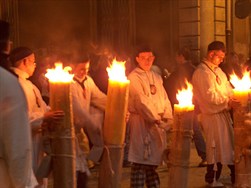Saint Agatha and fire
 There is a special bond linking Saint Agatha and fire. According to the hagiographic tradition Agatha, after being in detention, was tortured and her breasts were removed with red-hot pincers. In addition, on the order of the Roman governor Quinziano, who severely enacted the anti-Christian measures of the emperor Decius, because he had been rejected by Agatha, whom he had fallen in love with, she was rolled out on sharp shards and also on hot coals.
There is a special bond linking Saint Agatha and fire. According to the hagiographic tradition Agatha, after being in detention, was tortured and her breasts were removed with red-hot pincers. In addition, on the order of the Roman governor Quinziano, who severely enacted the anti-Christian measures of the emperor Decius, because he had been rejected by Agatha, whom he had fallen in love with, she was rolled out on sharp shards and also on hot coals.
The presence of fire in martyrdom (typical of many other saints, including Saint Lawrence, for example, tortured on a hot grill), however, assumes a special significance in the case of Agatha in Catania which is the vicinity of the city to Mount Etna the volcano of which is a source of constant danger due to the periodic release of lava. Here Saint Agatha has thus a role in the defense of the city as a protectress from the invasion of lava. The instrument of this prodigious intercession is the veil, one of the relics of the saint preserved in a silver chest in the cathedral. Tradition has it that this veil was that with which a woman had covered Agatha during her torture with hot coals. The first time the veil of Saint Agatha was used to stop the lava was on 5 February 252, the first anniversary of her martyrdom. Since then the saint’s veil was used periodically. The famous eruption of 1669 increased the consideration of the Saint Agatha’s power. On that occasion the lava in fact arrived at the limits of the city but spilled onto the sea without affecting the historical centre of the town and hence the places of the saint’s imprisonment and martyrdom.
The intervention by the Archbishop of Catania Dusmet in 1886 was likewise famous because he exposed Agatha’s veil at the entrance to Nicolosi, a small town on the slopes of Etna, which was not affected by the lava.
But another aspect that binds Agatha to fire is the enormous consumption of votive candles which takes place during the feast. The faithful promise to offer a candle to the saint in hopes of receiving an intercession for material or spiritual benefits. Thousands of people, having received the grace, deposit a candle on the fercolo during the feast, which are often large and carried at length on their shoulders.
Fire is also present in the copious use of fireworks that underpins the various stages of the feast and to which the public is much attached and well versed in.
